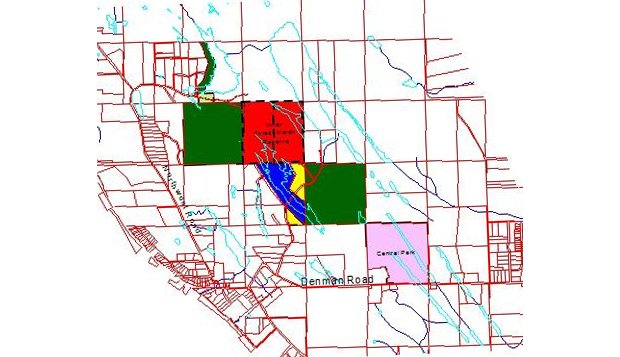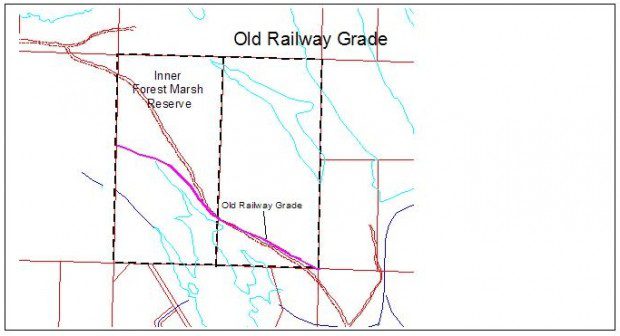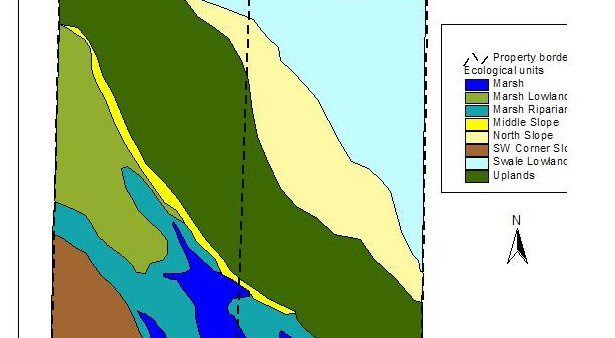March 2007
Extracts from a Report submitted by
J. Balke, RP Bio, to the
Denman Conservancy Association
Summary
This ecologically complex site is situated in the Coastal Douglas-fir moist maritime biogeoclimatic subzone, (CDFmm). The site consists of a large area of residual and regenerating forests, major wetland complexes, and pronounced slopes with rock outcrops. The forest on this site was one of Denman’s most significant old-growth Douglas-fir Pseudotsuga menziesii forest remnants. Most of the old growth Douglas-fir trees remain; however, the majority of second-growth forest cover was removed during “messy” clear-cut logging in 1999-2000 and the current forest is regenerating. Skid roads and landings are left from the recent logging and an orchard of old apples trees and sections of split rail fence remain from the original homestead.
The wetlands are many and varied. The two large wetlands, Pickles Beaver Pond and the swale are components of the headwaters of Denman’s largest Class A salmon stream, Beadnell Creek. Smaller sedge wetlands are isolated pockets in the Uplands and other areas. The slopes are NE and SW facing and range from approximately 5 to 30 m in height. Rock outcrops and their unique flora are found on the slopes, particularly the ridge crests in several locations.
Provincially important wildlife species including the Blue-listed Cutthroat trout Oncorhynchus clarki clarki and Red-legged frog Rana aurora are found on this site. Locally uncommon plant species for Denman that reflect the site diversity include Falsebox Pachistima myrsinites, Sitka spruce Picea sitchensis and Red osier dogwood Cornus stolonifera.
This site provides a key link in a network of protected areas on north Denman by connecting seven other important properties into a continuous corridor. The site also contributes a substantial area of land in diverse habitat types.
1.0 Conservation Significance
As described within this report, the Inner Forest Marsh Reserve fulfills at least six major conservation roles through the protection of:
- habitat occupied by endangered species,
- headwaters of a class A salmon creek,
- significant and varied wetland habitat,
- old-growth Douglas-fir veteran trees,
- outcrops of rock bluff habitat,
- large area of regenerating forest in the Coastal Douglas-fir biogeoclimatic zone.
2.0 Local Significance
This site is important to Denman Island in terms of conservation, biodiversity and local history.
2.1 Protected Areas Network
The site consists of a large area of land, a ¼ Section, with a broad diversity of habitats including cliffs, forests and wetlands. Thus, protection of the site makes a substantial contribution to the size of the protected area network and increases the chances for future survival of a variety of species, including those that are larger or more mobile.

Figure 1: Protected areas connected to the Inner Forest Marsh Reserve.
2.2 Biodiversity, Rare and Locally Significant Species
The Inner Forest Marsh Reserve is topographically diverse, covering various elevations, aspects and moisture gradients, therefore the site contributes significantly to Denman’s overall biodiversity. The site also hosts both rare and locally uncommon species. A portion of the site adjacent to Pickles Beaver Pond was relatively undisturbed until the recent logging in the late 1990’s, and this riparian area represented a valuable fragment of old growth forest on Denman Island and of the vanishing Coastal Douglas-fir moist maritime biogeoclimatic subzone vegetation. Many of the ancient Douglas-fir trees remain and this pocket habitat may retain native species, regenerate and contribute to the genetic legacy of the original forest constituents.
While a detailed vegetation assessment is warranted, particularly during the growing season, a brief examination demonstrated that the diverse habitats on this site contribute uncommon species for Denman, such as the dry-site evergreen shrub Falsebox Pachistima myrsinites, and wet-site Sitka spruce Picea sitchensis and Red osier dogwood Cornus stolonifera. Additional rare or uncommon vegetation may be present in these diverse ecosystems.
The wetlands contribute shallow water, fen, marsh, and swamp habitats, all of which are not common in the Islands Trust area and are highly threatened and of conservation concern in the Sensitive Ecosystem Inventory area1. The larger swale that continues adjacent to the east of this site is a sweet gale-Sitka sedge fen, (Wf52), which is uncommon in the Georgia Depression2. Wetlands are critically important for over-wintering waterfowl on the Pacific flyway, and they also provide habitat for a diverse array of fauna, including mammal, bird, amphibian, fish and invertebrate species. Pickles Beaver Pond contains blue-listed Cutthroat trout Oncorhynchus clarki clarki and is the headwaters for Denman’s largest Class A Coho salmon Oncorhynchus kisutch stream. The site is also home to blue-listed Red-legged frogs Rana aurora.
2.3 Historic
A brief historic summary of the site includes early glaciation, use by First Nations, railway logging of the old growth, early pioneer settlement and the work of islanders to protect the adjacent corridor lands. Currently visible historical markers are the occasional large boulders or erratic left by the glaciation, the imprint from the railway grade and the remains of an early pioneer homestead on the site.
In early logging operations, railways were used to transport the huge logs. Corridors were cut and levelled and rail lines were put down across the island to gain access to the old-growth timber. As they were needed, the rails were laid and then removed and taken to the next operation. Imprints of the railway grade corridors with their mounds, cut banks and rotting-corduroy ties remain. Such a corridor with rotting ties is evident on this property beginning on the eastern border as a cut, rising onto a mound near the marsh, sloping along the bank and then crossing into the next property as a cut. Another section of cut of unknown origin remains in the homestead area.
 Figure 2: Old railway grade route through Inner Forest Marsh Reserve.
Figure 2: Old railway grade route through Inner Forest Marsh Reserve.
A pioneering homestead site is located in the northwest corner of the site (Se Swale lowlands). The signs that remain include some ditching and a stand of very old fruit trees, currently enjoyed by sapsuckers and other wildlife.
3.0 Ecological Description
3.1 General overview
The site has both poor dry rocky and rich wet zones. There are large areas where the sandstone and conglomerate rock, worn down by glaciation, is exposed at or close to the surface, as well as lower “receiving-sites”, where runoff and moisture-supported vegetation have deposited thick rich soil and peat layers. A reference to the general geology of Denman and its influence on the topography is included in Appendix II.
The larger vegetation on the site consists of residual second growth forest with a mix of species including Douglas-fir, Grand fir Abies grandis, Western hemlock Tsuga heterophylla, Western red cedar Thuja plicata, White pine Pinus monticola, Big leaf maple Acer macrophyllum, Red alder Alnus rubra and rarely Sitka spruce. In addition, a large number of old-growth Douglas-fir veteran trees are also present. Most of the residual forest is in a corridor around Pickles Beaver Pond Marsh, along the Swale wetland and upper Pickles Creek, and in a patch of forest above the creek near the southwest corner of the site. The remaining residual trees are scattered as individuals or small patches across the site. While the old growth trees are distributed across the site, the majority are located around the Marsh. This riparian area with its concentration of old trees had been one of Denman’s best examples of remaining old growth forest.
The regenerating forest varies across the site. Most young trees are less than 3m and are a mix of species above, as well as Lodge pole pine Pinus contorta and Arbutus Arbutus menziesii. The shrub and herb layers also vary and the dominance of some species, such as bracken fern, which is deciduous, would be under-represented at this time of year. Certainly the landscape offers a complex of dominant patches of salal Gaultheria shallon, Oregon grape Mahonia nervosa, twin flower Linnaea borealis, black raspberry Rubus leucodermis, reed canary Phalaris arundinacea, other grasses, sedges Carex spp, spirea Spirea douglasii, willow Salix sp., or rushes Juncus effsus. The resulting forest will be a mosaic of site series due to the topography and resulting moisture and soil conditions, and due to the transitional nature of Denman’s vegetation from CDFmm to Coastal Western hemlock very dry maritime CWHxm.
The wetlands are also varied from shallow water and marsh habitat in the Marsh to large areas of fen in the Swale Lowlands and many small marsh and fen patches. The Skunk cabbage areas, particularly in the Fern Vale area of the Swale lowlands may redevelop into swamp habitat.
3.2 Ecological Management Units
These complex properties have been divided into eight convenient ecological / topographical units, to facilitate the property description and subsequent management options. The units are listed below as they occur on the property, roughly from north to south:
- Swale Lowlands
- North Slope
- Uplands
- Middle Slope
- Riparian & Peninsulas
- Marsh Lowlands
- Marsh (Pickles Beaver Pond)
- Southwest Corner Slope
 Figure 3: Ecological management areas of the Inner Forest Marsh Reserve.
Figure 3: Ecological management areas of the Inner Forest Marsh Reserve.
1 Ward, P, Radcliffe, G, Kirkby, J., Illingworth, J. and Cadrin, C. 1998. Sensitive ecosystems inventory: East Vancouver Island and Gulf Islands 1993-1997. Volume 1. Technical Report Series No. 320, Canadian Wildlife Service, Pacific and Yukon Region, British Columbia.
2 MacKenzie, W.H. and J.R. Moran. 2004. Wetlands of British Columbia. Res. Br., BC Min. For., Victoria, BC Land Manage. Handbook N0. 52.

